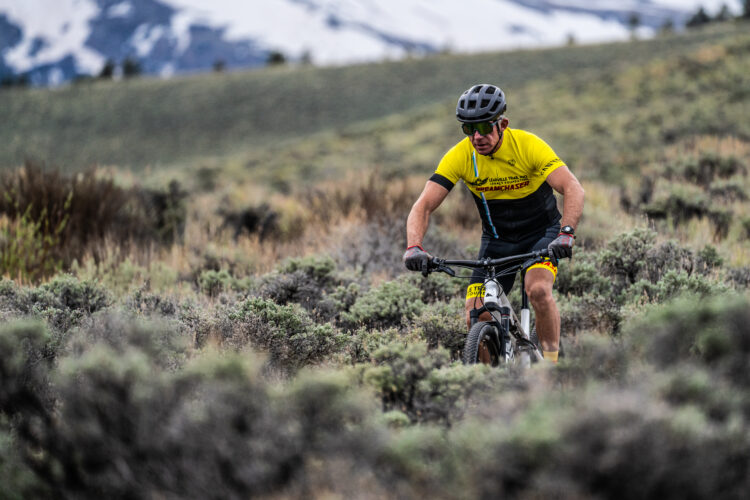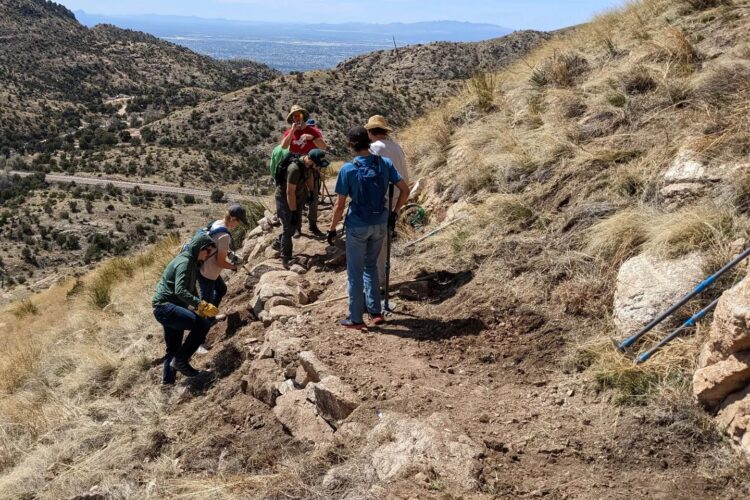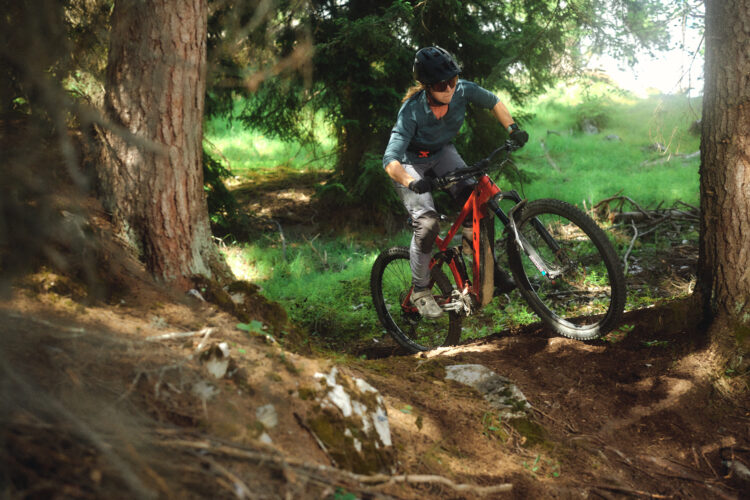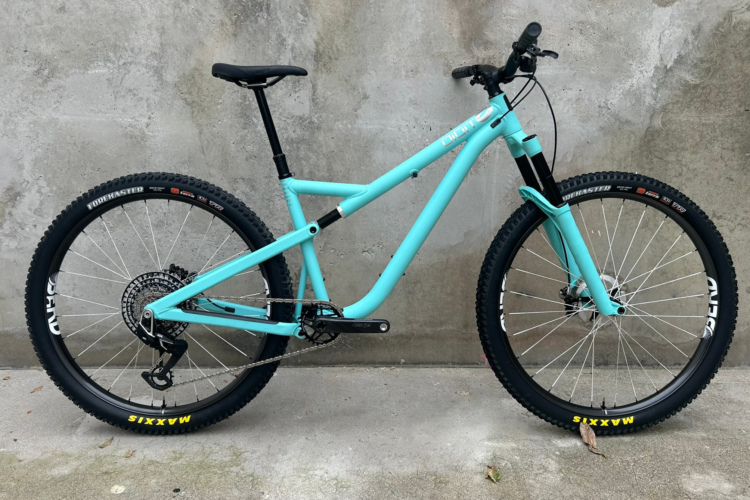
If the marketing materials are to be believed, the Yeti SB135 is a fun bike to ride. On the surface that might sound like a weak statement; all mountain bikes should be fun to ride after all. But it’s actually the culmination of a shift that’s been underway at Yeti for a while now, a brand that has long prided itself on designing bikes that are “race-bred” and “proven by the fastest riders in the most demanding conditions.” Curious to see if the brand might be turning over a new leaf, or at the very least further broadening their appeal, I decided to test the newly released Yeti SB135 this summer.

Yeti SB135 frame specs
Yeti is known for their meticulous frame design and construction, and the SB135 is no exception. I’ve been testing the LR T3 Turq build which features the brand’s highest quality carbon fiber and advanced layup techniques. Every cable is buttoned up as it enters and exits the frame for a sleek look and stealthy aura on the trail. Smooth lines and high-quality frame hardware make it clear this is a premium bike.
The XL frame I’ve been testing fits a huge 32oz. water bottle inside the front triangle, and even the XS frames make room for a mini bottle. Integrated frame protection flows along the underside of the downtube almost clear to the bottom bracket, and there’s a beefy, ribbed protector on the driveside chainstay as well.
The Yeti SB135 is UDH compatible, and this build comes with a SRAM X0 Eagle Transmission wireless drivetrain.
Key info
- Suspension travel: 160/135mm front and rear
- Frame highlights: UDH-compatible, Switch Infinity suspension, two levels of carbon (no aluminum option), XS frames fit riders down to 4’11”, all sizes include front triangle bottle mounts
- Geometry highlights: 65.4° HTA; 77° STA; 435mm chainstays and 479mm reach for size large frames
- MSRP: $6,400-$10,300 complete; $9,500 as tested
- Buy from Backcountry.
Aside from the Switch Infinity hardware, which I’ll get to next, there really isn’t anything unusual or unique about the SB135 frame. There’s no in-frame storage, or steering limiters, or bosses for mounting top tube snack bags. Are those things gimmicks, or great frame features? I guess it depends on the rider. Clearly Yeti has focused on getting the important things dialed rather than becoming distracted by shiny doodads.



Switch Infinity
Whenever I think about Switch Infinity, I picture a snake that’s eating its own tail. That is to say, my mind always ends up going in circles trying to grasp the charts, leverage curves, and engineer-speak that’s involved. After riding the bike for a couple months, and reading up on the tech, here’s my Spark Notes attempt at explaining what Switch Infinity does.
The Switch Infinity hardware, located just above the bottom bracket, effectively allows the lower pivot to switch directions, depending on where the bike is in its suspension travel. The main pivot moves up and down along a linear path which makes it possible to optimize the leverage curve for both pedaling and descending.
Yeti uses this ability to give the SB135 a flat anti-squat curve which provides a solid pedaling platform through the beginning and middle of the suspension travel. Once the lower pivot switches direction beyond the travel mid-point, anti-squat drops quickly and the suspension moves more freely.
While the Switch Infinity hardware sports the Fox logo and a flashy Kashima coating, note that there isn’t any sort of damper or shock inside. It’s basically an amalgam of bushings and hardware that’s designed to slide smoothly up and down while supporting the pivot bearing.
Geometry
The Yeti SB135 mostly leans on the progressive geometry first seen on the SB130 which was released a few years back. The 65.4° head angle was considered very slack for a mid-travel trail bike a few years ago, though by now most brands have caught up and validated Yeti’s geo choices. The 77° seat tube angle balances the front and puts the rider in a good position for climbing and weighting the bike front to back. Reaches aren’t crazy long, topping out at 504mm for the XL I’m testing.
| Yeti SB135 Geo | XS | SM | MD | LG | XL |
|---|---|---|---|---|---|
| SEAT TUBE LENGTH | 345 | 365 | 400 | 440 | 470 |
| TOPTUBE LENGTH | 534 | 566 | 598 | 620 | 647 |
| HEADTUBE ANGLE | 65.5 | 65.4 | 65.4 | 65.4 | 65.4 |
| EFF. SEAT TUBE ANGLE | 77 | 77 | 77 | 77 | 76.9 |
| ACTUAL SEAT TUBE ANGLE | 72.1 | 72.4 | 72 | 72.1 | 72.3 |
| CHAINSTAY LENGTH | 429 | 431 | 433 | 435 | 437 |
| WHEELBASE | 1128 | 1164 | 1199 | 1225 | 1257 |
| ESTIMATED BB HEIGHT | 337 | 337 | 337 | 337 | 337 |
| STANDOVER | 675 | 678 | 714 | 718 | 722 |
| HEADTUBE LENGTH | 92 | 101 | 107 | 118 | 129 |
| AXLE TO CROWN | 548 | 548 | 548 | 548 | 548 |
| OFFSET | 37 | 37 | 37 | 37 | 37 |
| STACK | 583 | 592 | 597 | 606 | 616 |
| REACH | 400 | 430 | 460 | 479 | 504 |
| FRONT CENTER | 699 | 733 | 766 | 790 | 820 |
| VERTICAL FORK TRAVEL | 145 | 145 | 145 | 145 | 145 |
Many of us were scratching our heads when Yeti announced that the SB135 would come with 27.5″ wheels front and rear, when most bikes in the trail and even enduro categories are running 29er wheels. Part of the argument is that 27.5″ wheels are just more “fun” (debatable) but more importantly, the smaller wheels allowed Yeti to better fit riders at the small and extra small end of the spectrum. Shorter riders will be stoked with the bike’s crazy low standover (675mm for size XS), the ability to run a dropper post with 150mm of travel (size small), and fitting a water bottle inside the front triangle.
Still, the Yeti SB135 keeps the bottom bracket height at a very reasonable 337mm (less than 1mm lower than the SB130), and even taller riders can take advantage of the short seat mast to run long-travel droppers (up to 200mm on XL frames).

The Yeti SB135 LR T3 Turq build
The LR T3 build I’ve been testing sits just below the top of the SB135 line, with full Fox Factory-level suspension and a high-end SRAM Eagle Transmission drivetrain. Up front the bike comes with a Fox Factory 36 fork with GRIP2 damper while out back there’s a two-position Fox Factory Float X shock.
Yeti specs the X0-level SRAM Eagle Transmission drivetrain, which I swapped out midway through my testing (and back again) for a GX-level Transmission drivetrain. The brakes are SRAM Code RSC with 200mm rotors front and rear.
Reviewer profile height: 190cm (6’3″) weight: 72.5kg (160lb) testing zone: Southeast, USA
With the LR T3 build buyers get an aluminum DT Swiss EX 1700 wheelset, though the wheels are upgradable to carbon for an extra fee. The 30mm-wide rims match nicely with the Maxxis Assegai 2.5″ EXO+ tire up front and Maxxis Minion DHR II 2.4″ EXO+ in back.




Rounding out the build kit there’s a 31.6mm diameter Fox Transfer dropper post (with 200mm travel on the XL I tested), a Yeti-branded WTB Silverado saddle, and mostly flat 35x800mm Yeti carbon bars.
My build with pedals weighs 15.04kg (about 33.2lb).

On the trail
Before testing the Yeti SB135 I don’t think I ever paid so much attention to my shock’s climb switch. Sure, flipping the switch usually firms the rear end up a little bit, but not so much that it was alway noticeable if I forgot to reset it at the start of a climb every now and then. With Switch Infinity suspension, moving from open to firm dramatically transforms the bike from a rowdy descender into an efficient climber. There’s no mistaking which mode you’re in.
Climbing
I ride hardtail mountain bikes often, and in firm mode the Yeti SB135 is almost indistinguishable from one. Mashing up climbs the seat stays firm with no discernible bob. The platform is so efficient that on particularly rocky and technical climbs I actually needed to open the shock up for a little extra traction and comfort on the way up. Even with the rear shock open, the Yeti SB135 still climbs better than any 130mm trail bike I’ve tested, open or closed.

Admittedly I forget to flip my rear shock switch somewhat regularly, and I can usually get away with it. But not on the Yeti SB135. It’s obvious which mode you’re in, and I quickly got used to flipping the switch at the top and bottom of every climb for max joy.
Grinding through tricky rock gardens I experienced fewer pedal strikes than usual. Looking at the bike’s solidly average bottom bracket height, it’s clear the suspension system deserves much of the credit for providing a solid platform that isn’t mushy or divy. Whether it’s putting in a burst of power, or a low speed rear wheel loss of momentum, the Yeti SB135 remains poised and above the fray.
Weighing more than 33lb with pedals, this LR T3 build isn’t a particularly lightweight trail bike. I suspect the heavy-duty tires are largely to blame, and while they offer tons of grip and confidence on the descents, they give a somewhat draggy feel to pedal transfers.
For that reason, if I were buying the SB135 I would personally choose the T2 Turq build. Aside from costing $1,500 less than the LR T3 build, on paper it’s almost three pounds lighter, weighing well under 30lb. The lighter-duty tires promise even more efficient pedaling as does the shorter, 150mm fork. Going to the shorter fork does mean a damper downgrade from GRIP2 to FIT4, so really the build choice comes down to what each rider values most. In that way it’s refreshing to see builds that aren’t just increasing levels of the same basic component spec but rather give buyers a chance to better fit the bike to their preferred riding style.

Downhill
Though I do enjoy being one of the first to the top of every climb, I like riding fast descents even more. True to form, Switch Infinity delivers smooth small bump and medium hit compliance in open mode all the way down the mountain. Sustained rock gardens are no problem and I found incredible control through sections where I might normally tap the brakes.
The 27.5″ wheels do lend a real playfulness to the Yeti SB135. Popping off lips and rocks is irresistible with the suspension lending a little extra bump to get the bike into the air. On one particularly flowy and jumpy descent at Coldwater Mountain my Garmin GPS jump detector was a constant chorus of beeps and “nice jump” alerts. Toward the bottom my legs eventually gave out from all the explosive pumps and once again had me wishing for a lighter weight bike.
One of the things I think this particular build could benefit from is a set of riser or at least medium-rise handlebars. In part this is a selfish desire to give me a better fit on the bike with a front end that is just too low for comfort. But also, a set of riser bars could make the bike even more capable when it comes to balancing the bike front to back on steeper descents.
I’d also like to see a different set of mountain bike brakes on this build, not necessarily for more power (the Code RSCs were fine for the most part) but just for something quieter in wet conditions. I haven’t had the same noise issues with Shimano or TRP brakes.
Yeti has some interesting things to say about the tail end of the SB135’s suspension curve. The SB135 product page says the leverage ratio is optimized to provide bottom out control “without making it impossible to reach full travel.” And on the Switch Infinity page Yeti claims the suspension system delivers “a feel that makes reaching full travel almost imperceptible to the rider.”
On the first point I can confirm that it is indeed possible to reach full travel, but on the second — that reaching full travel is almost imperceptible — I respectfully disagree. Because the SB135 descends so capably I forgot at times that I was riding a mid-travel trail bike, pushing higher and higher into the air on the flowiest downhill trails. Coming back to earth I definitely felt the bike bottom out on multiple occasions. I’ve tested plenty of bikes with suspension that feels bottomless, and the Yeti SB135 is not one of them.
The 160mm fork on this particular build further encourages the rider to push the SB135 to its limit. With a large 25mm differential between the fork and shock travel, it’s tempting to let the front end write checks that the rear end can’t cash. For me, I think one of the builds with a 150mm fork would be more appropriate for my riding style and ensure that I keep the bike within its limits.
To to brand’s credit, and Switch Infinity in particular, it’s clear that the bike uses all of its travel where it matters most, compared to some other designs that seem to hold the last bit of travel in reserve for truly out of character hits, if it’s even used at all. The SB135 knows its zone and makes the most of it. For riders who want a fully optimized trail ride, both up and down the mountain, I can’t think of a more appropriate bike. Just don’t go joining a jump jam with it.
Pros and cons of the Yeti SB135
Pros
- Incredibly efficient climber
- Dialed suspension for both tech and flow
- High quality frameset and build
- Two distinct build lines to fit individual ride styles
Cons
- Noticeable bottom out
- Fit may be challenging for tall riders

Bottom line
For an example of what a top-level, high-tech trail bike is capable of, look no further than the Yeti SB135. Everything about the bike has been highly optimized to deliver on both the climbs and descents, making for a fun and capable ride. If beating your friends up the climbs and down the descents is part of the fun for you, then consider the SB135 your race bike.
- Price: $6,400-$10,200
- Buy from Backcountry.



















